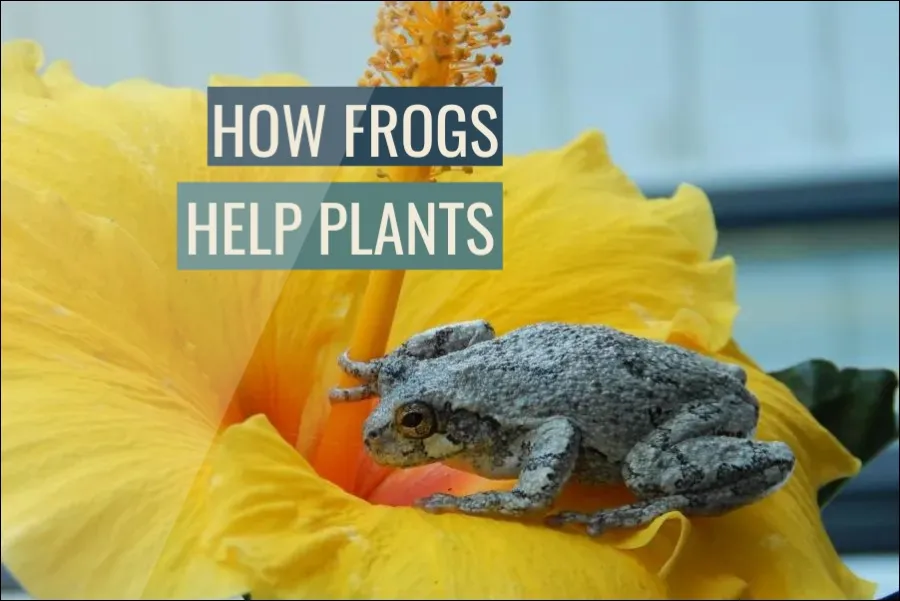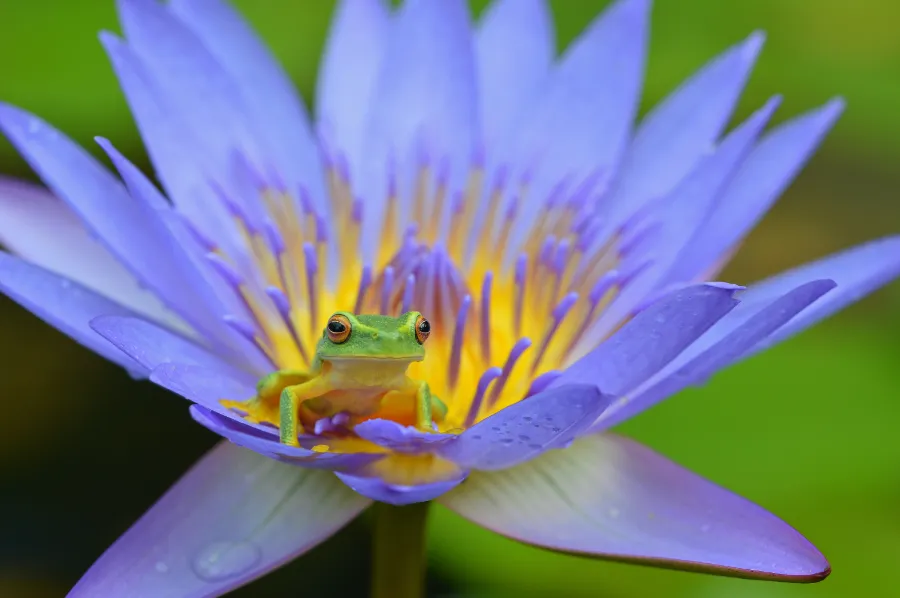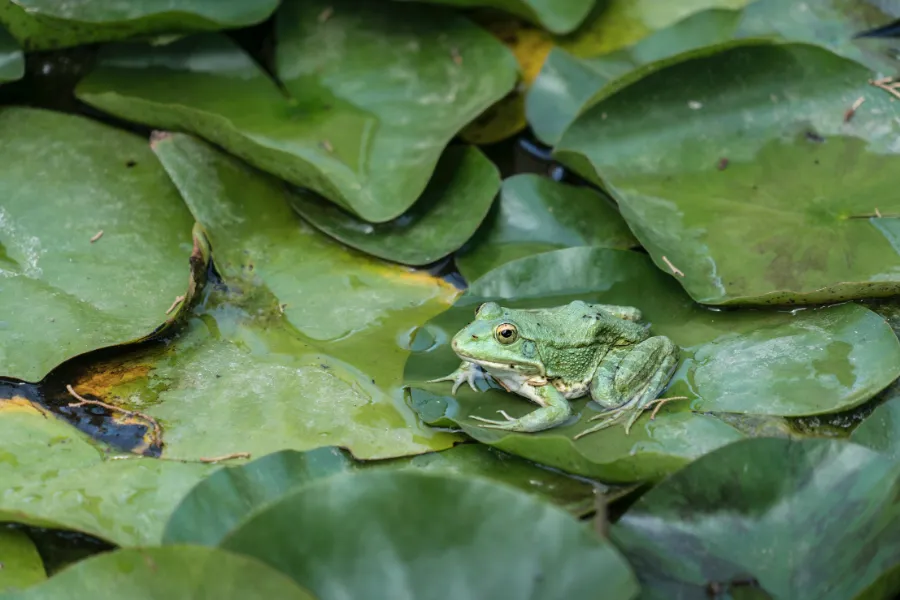
Frogs may seem small and insignificant, but they play a vital role in the health and survival of plants. In fact, frogs are often considered to be keystone species in their ecosystems, meaning that they have a disproportionately large impact on the environment relative to their size.
Frogs help plants by dispersing seeds, pollinating flowers, controlling pest populations, and improving soil health. They also play a role in ecosystem dynamics and are important indicators of ecosystem health. Preserving frog habitats is important for plant conservation.
In this article, we’ll explore how frogs help plants and the various ways in which these two groups interact.
How frogs disperse plant seeds
Frogs are significant plant seed dispersers because their digestive systems can transfer seeds over vast distances. When a frog consumes a fruit or seed, the seed travels through the frog’s digestive tract and is frequently deposited in a new spot when the frog defecates. This mechanism, known as endozoochory, can aid in plant colonization and dispersion. Furthermore, the abrasive activity of a frog’s stomach can aid in the breakdown of the seed coat, increasing the seed’s chances of germination. Some studies have even discovered that seeds that travel through a frog’s intestines germinate faster than seeds that do not. As a result, frogs play an important role in the survival and spread of many plant species.
How frogs pollinate flowers
Many frog species assist pollinate flowers as they wander from plant to plant in quest of food, in addition to distributing seeds. Frogs are drawn to the nectar generated by flowers and may frequently visit several plants in a single night. They may transmit pollen from the male parts of one flower to the female parts of another as they migrate from blossom to bloom, therefore fertilizing the plant and producing seeds. While birds and insects are more frequently recognized as pollinators, frogs can also play an important role in pollinating some plant species, particularly in locations where other pollinators are uncommon.
The role of frogs in controlling pest populations
By consuming insects that harm plants, frogs can help manage pest populations. Many frog species feed on insects that can infest crops and ornamental plants, such as aphids, mites, and other pest species. Frogs can help reduce pest populations and safeguard plants by eating these insects. Furthermore, certain frog species release poisons from their skin that might discourage pests and protect the plants on or near where they reside. As a result, both in agricultural settings and in natural ecosystems, frogs can provide essential pest management services for plants.
The impact of frog declines on plant communities
Frog population declines can have a deleterious influence on plant ecosystems by upsetting the predator-prey balance. Frogs are frequently important predators in their ecosystems, preying on insects and other tiny creatures that might harm plants. When frog numbers diminish, these predators are no longer there to manage pest populations, which can lead to increased insect damage and plant health problems. Furthermore, the extinction of frogs can have a domino effect on other species that rely on frogs for food or refuge, further altering the ecosystem’s equilibrium. As a result, conserving frog populations is critical not just for the benefit of the frogs themselves, but also for the health and survival of plant ecosystems.
The importance of preserving frog habitats for plant conservation
Frog habitats are crucial for plant conservation because they generally sustain a varied range of plant species. Frogs may be found in a variety of ecosystems, including forests, marshes, and grasslands, and many plants have evolved to thrive in these environments. Furthermore, frog habitats frequently provide critical ecological services such as water filtration and flood control, which can help plants develop and survive. As a result, safeguarding frog habitats can also help conserve plant species that rely on them for life.
The relationship between frogs and mycorrhizal
Frogs and mycorrhizae, fungi that help plants absorb nutrients from the soil, are known to share a symbiotic connection. Mycorrhizae and plants have a mutualistic interaction in which the fungus supply nutrients in return for sugars generated by photosynthesis. Frogs can assist support this association by disseminating mycorrhizae spores through their motions and activities. Furthermore, the presence of frogs in an ecosystem can promote the growth and survival of mycorrhizae by providing moist surroundings and nutrients in the form of their feces. As a consequence, frogs can indirectly aid plants in absorbing more nutrients from the soil and overall health.

The role of frogs in seed germination
Frogs’ movement and behavior can enhance seed germination. Many plant species rely on animals to disrupt the soil and expose their seeds to germination conditions like light and moisture. Frogs can facilitate this process by digging tunnels or making depressions in the soil, which exposes seeds to the optimal circumstances for germination. Furthermore, the presence of frogs can generate microclimates that are more conducive to seed germination, such as increasing humidity or changing soil temperature. As a result, many plant species rely on frogs for survival and reproduction.
How frogs contribute to soil health
Frog excrement can help to improve soil health by contributing nutrients and stimulating microbial activity. Frogs excrete a range of waste products, including urine and feces, which can provide nitrogen, phosphorous, and potassium to the soil. Furthermore, the presence of frogs can stimulate the activity of microorganisms in the soil, such as bacteria and fungus, which can aid in the breakdown of organic matter and the improvement of soil structure. As a result, frogs can contribute to improved soil conditions that support plant development and health.
The role of frogs in ecosystem dynamics
Frogs influence ecosystem dynamics through interacting with other species and affecting processes such as decomposition. Frogs are important predators in many environments, and by feeding on other species, they may help manage their numbers. Furthermore, frogs are prey for other species such as snakes and birds, and their existence might influence their behavior and distribution. Frogs may also impact organic matter decomposition by digesting dead plants and animals and breaking them down into smaller chemicals. As a result, frogs have the potential to shape the structure and function of ecosystems.
The ways in which people can support frog and plant health
People may help frog and plant health in a variety of ways. One method is to maintain and preserve frog habitats, such as through supporting conservation initiatives or developing frog-friendly gardens. Furthermore, individuals may reduce pollution and utilize sustainable gardening techniques, such as pesticide reduction and water conservation, to produce better settings for both frogs and plants. Finally, individuals may assist to create awareness and support for conservation initiatives by educating others about the value of frogs and plants and the ways in which they interact.

Are frogs good to have around?
Frogs are typically thought to be beneficial to the environment since they give a variety of ecological advantages. Frogs are significant indicators of ecosystem health because they are sensitive to environmental changes and can act as an early warning system for issues such as pollution or habitat loss. Furthermore, frogs play an important role in pest population management since they feed on insects that might harm crops and plants. Frogs promote soil health by contributing nutrients and promoting microbial activity, and they may pollinate flowers and disseminate plant seeds. Finally, frogs play a vital role in the food chain, acting as both predators and prey while also affecting the behavior and distribution of other species. As a result, having frogs around may benefit both the ecosystem and humans.
Keep frogs around all year around
Frogs are beneficial to plants all year because they provide a variety of ecological advantages that can assist promote plant health. Frogs are significant indicators of ecosystem health because they are sensitive to environmental changes and can act as an early warning system for issues such as pollution or habitat loss. Furthermore, frogs play an important role in pest population management since they feed on insects that might harm crops and plants. Frogs promote soil health by contributing nutrients and promoting microbial activity, and they may pollinate flowers and disseminate plant seeds. Finally, frogs play a vital role in the food chain, acting as both predators and prey while also affecting the behavior and distribution of other species. As a result, keeping frogs around all year can benefit both the environment and plants. If you want to learn more about how you can help frogs all year, read these articles: “How to Help Frogs in the Spring,” “How to Help Frogs in the Summer,” “How to Help Frogs in the Fall,” and “How to Help Frogs in the Winter.” On really hot days, you may wish to boost your assistance to the frogs. Check read my post How To Help Frogs In Hot Weather for more information.
In conclusion
Frogs are little but powerful organisms that play an important role in plant health and survival. Frogs are frequently regarded as keystone species in their ecosystems, which means they have a disproportionately big influence on the environment in comparison to their size. Frogs aid plants in a variety of ways, including seed dispersal through their digestive systems, pollination of flowers, insect population control, and soil health. Furthermore, frogs influence ecosystem dynamics through interacting with other species and affecting processes such as decomposition. Frog population declines can have a deleterious influence on plant communities by disturbing the balance between predator and prey and upsetting the ecosystem’s equilibrium. As a result, it is critical to protect frog habitats for the sake of both frogs and plants. People may help frog and plant health in a variety of ways, including conserving and maintaining frog habitats, reducing pollution, and using sustainable gardening practices. We can endeavor to develop healthier ecosystems that promote the survival and prosperity of both groups by better understanding the intricate and interrelated interactions between frogs and plants.
